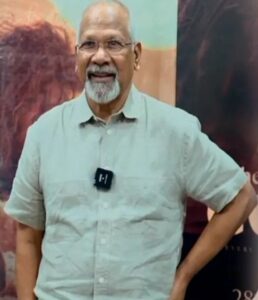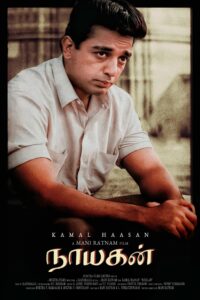Thug Life appears to belong to the genre of gangster drama with a liberal dose of high-octane action and bloodshed.
Published Jun 01, 2025 | 11:57 AM ⚊ Updated Jun 01, 2025 | 11:57 AM

The name of Kamal’s character in Thug Life, Rangaraya Sakthivelu Nayakkar, along with a shot of a young, clean-shaven Kamal in the trailer, hints at a connection to the original film, Nayagan.
Synopsis: The teaser and trailer make it clear that Thug Life is a gangster drama reminiscent of Nayagan. The question is whether it begins where Nayagan left off. Pulling off a sequel to an iconic film is always a herculean task. Has Mani Ratnam tried to emulate the success of Godfather II as a sequel to Godfather?
If you are even a passive follower of Tamil cinema, you cannot escape the onslaught of Thug Life on your social media feeds lately.
Thug Life, the upcoming film by Kamal Haasan and co-produced by his production house, Raj Kamal International, is a coming together of the thespian star and Mani Ratnam, one of the most accomplished filmmakers in Indian cinema. The only time they collaborated in the past was on Nayagan, a landmark film not only for Tamil cinema but for Indian cinema.
Nayagan showcased a new storytelling style that deftly mixed a high quality of craft and content not seen in Tamil cinema before. Nayagan established a new grammar for realistic filmmaking in Tamil.
In an overkill of marketing and promotions, which has become the trend these days, Kamal, Mani Ratnam, and the film’s crew have been discussing the movie non-stop for the past two to three weeks. A film that is over-promoted raises a whiff of scepticism among industry watchers if all the noise is to ensure a huge opening before the word-of-mouth feedback and reviews kick in and deflate the hype.

Director Mani Ratnam.
In Tamil, over the last 12 months, films like Indian-2, Kanguva, and Vidaamuyarchi have been examples of films that were excessively promoted, got a massive opening, but ultimately flattered to deceive. It is nobody’s argument that films should not be marketed; it is just that too much of anything can be detrimental.
It has often been established that a “good” film, even if not promoted heavily, gets the cash registers ringing due to word-of-mouth feedback.
In 1987, however, when Nayagan was released, there was hardly any film promotion besides posters, banners, and cutouts. Beyond being a Kamal film, what piqued everyone’s interest in Nayagan was that the posters showcased a pensive, clean-shaven Kamal for the first time.
Before the film’s release, there were hardly any indications of what the film was about. It was Mani Ratnam’s first film with Kamal, one that became an epic association in the years to come.

Kamal Haasan is collaborating with Mani Ratnam 38 years after Nayagan was released.
When Nayagan was released, Mani Ratnam was still a relatively new filmmaker. Although he showed great promise in earlier works like Pagal Nilavu (1985), Idhaya Kovil (1985), and Mouna Ragam (1986), he had yet to gain the reverence he enjoys today.
Nayagan changed everything. It is a cult classic that is heavily discussed among film enthusiasts and regarded as a film that germinated many filmmakers in South Indian cinema. Even for Kamal, Nayagan was a landmark film in his
filmography.
One can clearly see that after Nayagan, his choices of films became more adventurous and purposeful when he started putting a premium on his skill and talent.
It is therefore surprising that it took 38 years for Mani Ratnam and Kamal to collaborate on a film after a successful outing like Nayagan.
I could only think of a couple of reasons for this: First, besides being an ace actor, I believe Kamal views himself as a director. Although he has directed only a handful of films so far, his influence as a director is unmistakable in films in which he starred, particularly in the post-Nayagan era.
Films like Thevar Magan (1992), Aalavanthan (2001), Mahanadhi (1994), Anbe Sivam (2003), and Uthama Villain (2015) are examples of films he did not direct, but in which his shadow as a director is evident. The same applies to comedies like Apoorva Sagotharargal (1989), Michael Madana Kama Rajan (1990) and Pammal K Sambandam (2002).
Therefore, Kamal likely hesitated to work with Mani Ratnam, whom he viewed as a competitor of sorts.
Second, neither Mani Ratnam nor Kamal found any suitable subjects that might be as interesting, if not more so, than Nayagan. Thug Life was the film they both concluded would be a worthy follow-up to an iconic movie like Nayagan.
In many interviews while promoting Thug Life, both Kamal and Mani Ratnam stated they were in constant touch and discussed many scripts, but for some reason, the stars didn’t align.

‘Thug Life’ appears to belong to the genre of gangster drama with a liberal dose of high-octane action and bloodshed.
Now that they have come together and the film is just a few days away from hitting the big screen, expectations are at an all-time high. That an ace director and an ace actor are coming together after a gap of three decades is enough to draw the audience to the theatres. Already, Rahman’s songs from the film are topping the charts. The song Jingucha would soon be part of wedding playlists in the South.
Kamal and his company, Raj Kamal International, are on a high after back-to-back super hits like Vikram (2022) and Amaran (2024). The failure of Indian -2: Zero Tolerance (2024) has not cast any aspersions on Kamal, the performer.
After Ponniyin Selvan-1 and 2 (2022 and 2023), Mani Ratnam is also riding a wave in his career. Any doubt about whether he can still be relevant as a filmmaker after average outings like Kaatru Veliyidai (2017) and Chekka Chivantha Vaanam (2018) has completely vanished, seeing how he translated author Kalki’s serial epic onto the big screen and made engaging films of it in two parts.
The teaser and trailer make it clear that Thug Life is a gangster drama reminiscent of Nayagan. The question is whether it begins where Nayagan left off. Pulling off a sequel to an iconic film is always a herculean task. Has Mani Ratnam tried to emulate the success of Godfather II as a sequel to Godfather?

A poster of ‘Vikram’.
The name of Kamal’s character in Thug Life, Rangaraya Sakthivelu Nayakkar, along with a shot of a young, clean-shaven Kamal in the trailer, hints at a connection to the original film, Nayagan. From what we have seen, other than Kamal’s character, the only other link seems to be actor Naasar.
In an interview to Anupama Chopra of The Hollywood Reporter, India, Kamal said that the germ of the idea for Thug Life came from the script of a film, Amar Hain, which he wrote many years ago but didn’t make it. It is the story of a character, Amar, who is believed to be dead, but he isn’t. Mani Ratnam took the script and reprised it in his own way, bringing the Nayagan element into it.
This also reminded me of what Kamal said to film critic Baradwaj Rangan on Galatta Plus about how Vikram’s storyline came about. He said that when he had decided to work with Lokesh Kanakaraj for a film, Lokesh had brought a story idea to him, which was good.
But Kamal suggested to him an alternate idea he had, based on the 1949 English film, The Third Man, directed by Carol Reed. In this film, the character played by Orson Welles was said to have been killed in a road accident. But it is found later that he was still alive. This idea was taken by Lokesh, who worked on it to make it a sequel to Kamal’s 1986 film, Vikram, which went on to become a blockbuster.
Incidentally, Fahadh Faasil’s character in Vikram is named Amar! So, I guess that Kamal prompted the idea of Amar Hain to both Lokesh and Mani Ratnam, and they have both given their spin to the storyline and came up with their own respective sequels to Vikram and probably Nayagan.
Thug Life appears to belong to the genre of gangster drama with a liberal dose of high-octane action and bloodshed.

Kamal Haasan. (X)
According to Kamal, the film’s core message is “Crime doesn’t pay, however much it pays.” From this perspective, too, it serves as a sequel to Nayagan, where the theme was “Nothing is wrong if it is good for people,” but ends with an unspoken message that crime doesn’t pay, even if you are mighty.
In an interview with Cinema Express as part of the film’s promotion, Kamal stated, “With this film, we want to make sure you forget Nayagan.”
While we hope that the eventual reunion of Mani Ratnam and Kamal for Thug Life turns out to be another landmark for Indian cinema, it is difficult for those who grew up in the 1980s to erase Nayagan from their memories.
Even Mani Ratnam probably doesn’t want that to happen. After all, even in Thug Life, Vinveli “Nayagaa…” makes an entry and how!
(Views are personal. Edited by Majnu Babu).
